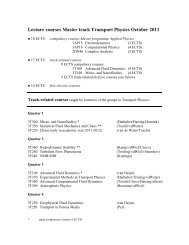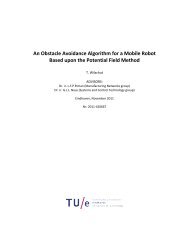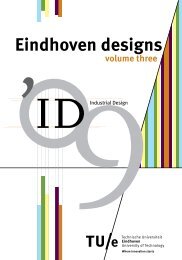Self-evaluation - Technische Universiteit Eindhoven
Self-evaluation - Technische Universiteit Eindhoven
Self-evaluation - Technische Universiteit Eindhoven
You also want an ePaper? Increase the reach of your titles
YUMPU automatically turns print PDFs into web optimized ePapers that Google loves.
Appendices self-<strong>evaluation</strong> research programme ESoE<br />
problems in the realization of this objective, because there are four different trajectories. Students of<br />
the different trajectories have different “needs”. It seems that the program is particularly constructed<br />
for those students who choose the total two-year master’s program after their bachelor.<br />
However, most of the students (90%) choose the one-year trajectory and combine the program with a<br />
job as a teacher. Especially master’s students having a teaching job face a complicated situation and<br />
are not really motivated to do theoretical studies. ESoE is searching for a balance between an<br />
academic and a professional orientation. Students, however, feel that this balance is lacking. They find<br />
that the program cannot give the answers to the daily problems they are confronted with as teachers<br />
(classroom management, how to handle difficult children, …). They find that what is taught is not<br />
sufficiently applicable to their needs. They expect more training concerning hand-on skills. On top of<br />
that, the combination of working and learning results in a high study load.<br />
The <strong>evaluation</strong> committee suggests working out a different trajectory for students who are teaching<br />
and to redesign the problem in order to realize the SBL-competences. In that way, the pedagogy of<br />
teacher education can be more oriented toward the concerns of those beginning teachers and bridge the<br />
gap between theory and practice through reflection on this practice. One of the prior objectives in<br />
rethinking the program for those student teachers is to restore their learning and studying motivation,<br />
so that they become receptive again to a broader vision of teaching and to an academic orientation.<br />
Another problem is related to learning at the workplace. Support for the students in the twoyear<br />
trajectory is very well organized in terms of their school contracts through which schools oblige<br />
themselves to make the workplace a learning environment and to provide supervision, guidance, and<br />
possibilities for intervision in the schools. In many cases, workplace learning takes place in so-called<br />
“professional development schools” (in Dutch: academische opleidingsscholen). Educating student<br />
teachers is part of the regular work of these schools. This is not always the case in “regular” schools.<br />
The students of the one-year trajectory already have a job as a teacher. These student teachers describe<br />
their progress with the SBLcompetencies in their portfolio and complete their assignments. Those<br />
assignments are evaluated by the students as not always related sufficiently to their job, and the<br />
students need more feedback on this work on a regular basis. In addition, they need more thorough<br />
guidance on the work floor, in their own school. ESoE needs to improve coordination and integration<br />
of all partners in teaching, e.g., in connection with workplace learning. Sometimes the partners are not<br />
reporting to each other, or, e.g., the teachers do not observe the practical work of their students. ESoE<br />
must explore the possibilities for more direct contact between the teaching staff of ESoE (especially<br />
the teaching staff of the domain-specific didactics) and the schools the student teachers work in. The<br />
support student teachers get from Fontys University of Applied Sciences is evaluated as insufficient.<br />
There is no link between ESoE and the school supervisors of Fontys. The way student teachers are<br />
supported by Fontys for their learning in the workplace must become more formalized.<br />
Concerning the Minor’s program, the <strong>evaluation</strong> committee judges that the program is well balanced<br />
and consistent, and there is evidence that the aims and objectives are fulfilled. The study load is<br />
feasible. Students taking this program are satisfied.<br />
Teaching staff<br />
As stated in the self-assessment report, the networking character of ESoE offers great opportunities,<br />
but also poses some serious challenges. The <strong>evaluation</strong> committee remarked that all staff members<br />
have strong backgrounds in their respective fields of expertise, but due to the part-time presence of<br />
most of them, they cannot take enough time for sharing ideas and experiences. It is important that the<br />
management team of ESoE acknowledges this problem.<br />
Part-time committed colleagues find it harder, understandably, to identify themselves fully with ESoE.<br />
This exerts some pressure on the presence and visibility of ESoE in external participatory networks,<br />
i.e., in both professional networks and in network activities of secondary schools. The teaching staff is<br />
conscious of this problem. ESoE needs to a larger extend full-time staff for the core business.<br />
ESoE has chosen the option for an integrated program combining subject-related expertise and<br />
pedagogical knowledge. This means that ESoE has to create more opportunities for the teaching staff’s<br />
learning activities in the direction of a new pedagogy of teacher education that supports this integrated<br />
program. More support and space to carry out research in domainspecific didactics would also<br />
strengthen these learning opportunities. Without staff members conducting any research in this area it<br />
is a concern that the quality of academic teaching would be rather low.<br />
83

















